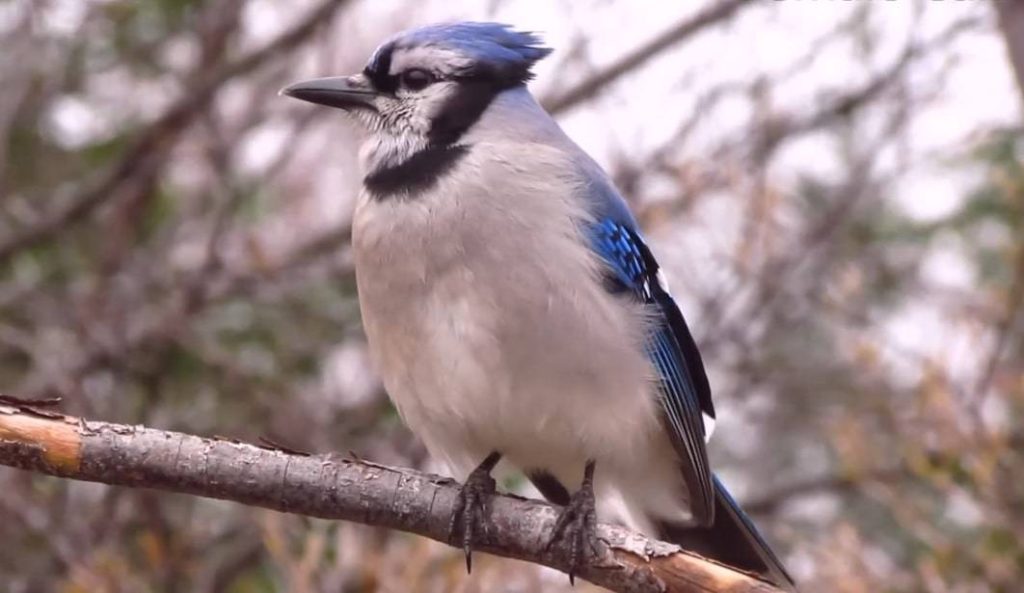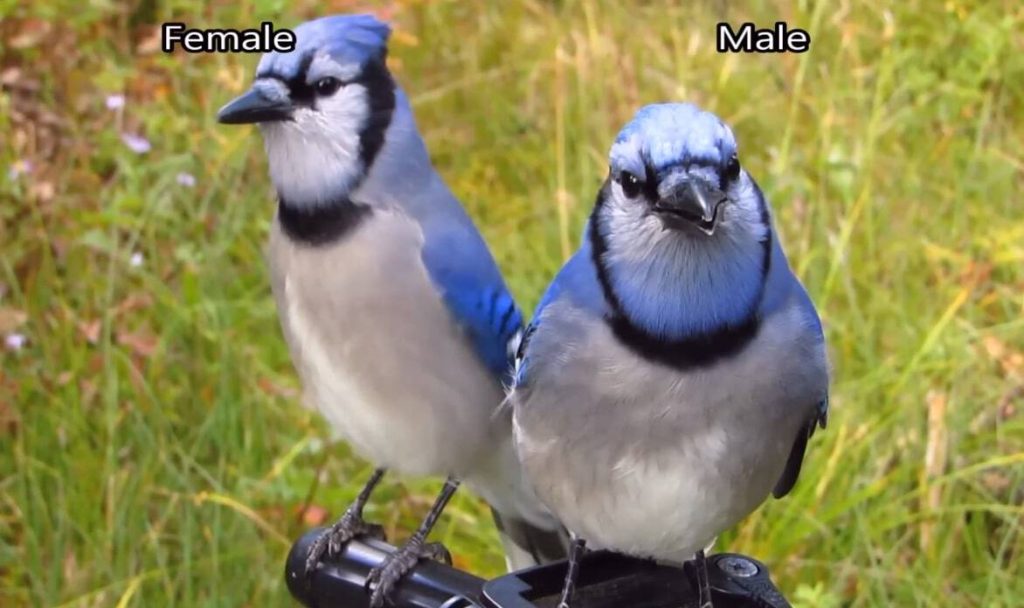Blue Jays are feminists. This is a bird species that believes in the equality of both males and females. Of course, females lay the eggs, but everything else is shared.
The male and the female seek out good locations for breeding and nesting. Then, they go out to seek out building materials for their nests, build them, and take turns tending to their hatchlings.
This equality is also one reason that the uninitiated cannot tell a male from a female. Keep reading to discover more about the enigmatic females of the species.
What Does a Female Blue Jay Look Like?

Blue jays have crests and a full blue look with white or gray underbelly. Their feathers have different shades of blue in them, and they have a dark band around their necks that looks like a necklace.
Blue jays are songbirds despite belonging to the Corvidae family – yes, they are cousins with crows and magpies. This also implies they’re smart birds because both crows and magpies are among the smartest birds on earth.
Now that we have re-educated ourselves on what blue jays generally look like, here’s a comparison between male and female blue jays that will help to answer the question of what a female blue jay looks like.
Male vs Female Blue Jay

| Male Blue jays | Female Blue jays |
| Slightly bigger | Smaller |
| Mostly white underbelly | Gray or white underbelly |
| Limited number of calls (bird noises) | More calls than the male |
Not much separates males from females. But if you can’t make out these physical traits, here are a few more factors that will help you differentiate between the two genders when observing blue jays.
Nesting Behavior
This is one of three core differences when comparing a male & female blue jay.
The female chooses the best site where she will nest and breed her young. Building their nests takes a week, during which they both participate equally in building a sample nest to determine the size of their actual nests.
The female blue jay selects the nesting site by rubbing her chest on the location, which alerts the male to her decision.
Both gather the nesting materials—twigs, mud, and freshly fallen leaves—and use them to build the practice nests first. If the nests are up to standard, the female takes over and builds the actual nest for breeding.
When it’s time to lay eggs and incubate them, the male leaves the nest to source food while the female does her thing.
The female only leaves the nest during the breeding period to stretch, preen, relieve herself, or take food from the male if he’s taking too long.
This happens for the next two weeks, after which the female leaves the nest for the hatchlings and joins her male mate in foraging for food for their new family and living their best lives.
Dietary Preferences
Both males and females eat the same things.
Blue jays diet consists of peanuts, sunflower seeds, and suet. They also enjoy acorns but have to contend with squirrels and other birds for them.
So plant more oak trees so that there will be acorns available for jays of the future.
Blue jay beaks/bills allow them to pick up insects and worms, which form the protein part of their diet. If you have set out feeders for them, add mealworms, as they especially love this food source.
Blue jays have also been said to take and eat the eggs and hatchlings of other birds.
This means birds that are smaller than them are at risk of losing their young to a hungry blue jay. Luckily for the smaller bird population, only about one percent of blue jays were discovered to have this dietary preference.
Some in the birding community have also reported that blue jays enjoy ice cream, dog food, cereals, walnuts, and cottage cheese.
The males take these things from the bird feeders to the females in their nests and bring them along to eat directly from the feeders when their incubation period is up.
Adaptations and Survival Strategies
You will recall from an earlier section of this article that male and female blue jays have different calls. This is how both have adapted to their environment for survival.
Blue jays mate for life – they settle on one mate and stay with them until the end of their breeding years and/or death.
In breeding seasons, when each mate begins to take responsibility for their roles, the female is mostly at a disadvantage.
This is because the female spends the first two weeks with the nestlings to incubate them and only ventures a few feet away from the nest to stretch.
To survive this period, female blue jays have a “begging” call, which their mates are attuned to. Once the mate hears this, they know it’s time to bring home some food for the female and the babies.
In the case of a lost or missing mate, the female adapts by making quick trips to forage for food they store for themselves and their young nestlings.
Also, in the case of a predator’s approach, the female makes another call to alert her male. The male quickly returns and helps with protecting or relocating their nest.
Population Trends and Distribution of Female Blue Jays
Female Blue Jays are responsible for selecting the breeding grounds for their families. And so, as adaptable birds, they can be found in many places.
However, they are commonly found in forests, woodlands, and suburban areas. They thrive in mixed deciduous-coniferous forests, where they can nest and forage. Their preferred trees for nesting are oaks and beeches.
Blue jays are generally native to North America, ranging from southern Canada down to Florida and west to Texas.
They can be found all year round in these areas, so they are not the most migratory birds.
In different seasons, they just change location in the same spaces based on which ones offer them the best cover from the elements.
Some migrate, however, and the pattern of their migration remains a mystery even to the most informed ornithologists.
Blue jays are prey to snakes, squirrels, and small mammals. This means the female is responsible for selecting a nesting area where these predators cannot easily reach her or her young.
This is why they are mostly found in suburban areas – areas with a good mix of trees and humans who are less likely to harm them.
Final thoughts
One thing to note is that blue jays may become endangered soon.
Now, this is a long-term prediction which is based on the rapid rate of urbanization that is occurring in many areas.
Outside their natural predators, urbanization and gentrification are some of the threats to their existence.
The female is important to this species not just because of breeding but because they decide where a family calls its home. When she cannot find a place to call home, she is forced to live among predators.
Take care of the blue jays around you, friend!

